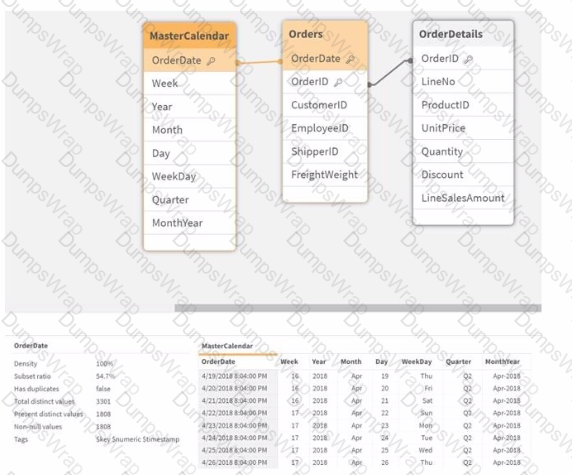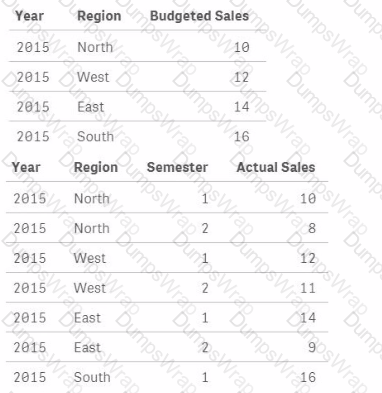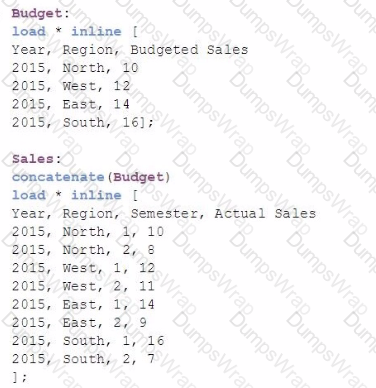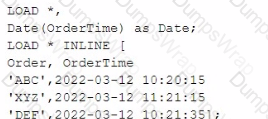Qlik Sense Data Architect Certification Exam – 2024 Questions and Answers
Exhibit.

Refer to the exhibit.
A business analyst informs the data architect that not all analysis types over time show the expected data.
Instead they show very little data, if any.
Which Qlik script function should be used to resolve the issue in the data model?
A data architect needs to load Table_A from an Excel file and sort the data by Reld_2.
Which script should the data architect use?
A)

B)

C)

D)

Exhibit.

While performing a data load from the source shown, the data architect notices it is NOT appropriate for the required analysis.
The data architect runs the following script to resolve this issue:

How many tables will this script create?
Exhibit

Refer to the exhibit.
The salesperson ID and the office to which the salesperson belongs is stored for each transaction. The data model also contains the current office for the salesperson. The current office of the salesperson and the office the salesperson was in when the transaction occurred must be visible. The current source table view of the model is shown. A data architect must resolve the synthetic key.
How should the data architect proceed?

Refer to the exhibit.
What does the expression sum< [orderMetAmount ]) return when all values in LineNo are selected?
Users of a published app report incomplete visualizations. The data architect checks the app multiple times and cannot replicate the error. The error affects only one team.
Which is the most likely cause?
A data architect needs to retrieve data from a REST API. The data architect needs to loop over a series of items that are being read using the REST connection.
What should the data architect do?
A data architect wants reflect a value of the variable in the script log for tracking purposes. The variable is defined as:

Which statement should be used to track the variable's value?
A)

B)

C)

D)

Exhibit.

Refer to the exhibit.
A data architect is provided with five tables. One table has Sales Information. The other four tables provide attributes that the end user will group and filter by.
There is only one Sales Person in each Region and only one Region per Customer.
Which data model is the most optimal for use in this situation?
A)

B)

C)

D)


Refer to the exhibit.
A data architect needs to create a data model for a new app. Users must be able to see:
• Total sales for each customer
• Total sales for a given state
• Customers that have not had any sales
• Names of salesperson and regional account managers
• Total number of sales by date
Which steps should the data architect perform to meet these requirements?
Which steps should the data architect perform to meet these requirements?
Exhibit.

A data architect must load the two tables without creating a synthetic key. The data architect also must make sure expressions like Sum([Budgeted Sales]) are calculated correctly.
Which load script meets these requirements?
A)

B)

C)

D)

A table is generated resulting from the following script:

When the data architect selects a date, some, but NOT all, orders for that date are shown.
How should the data architect modify the script to show all orders for the selected date?
A)

B)

C)

D)

The data architect has been tasked with building a sales reporting application.
• Part way through the year, the company realigned the sales territories
• Sales reps need to track both their overall performance, and their performance in their current territory
• Regional managers need to track performance for their region based on the date of the sale transaction
• There is a data table from HR that contains the Sales Rep ID, the manager, the region, and the start and end dates for that assignment
• Sales transactions have the salesperson in them, but not the manager or region.
What is the first step the data architect should take to build this data model to accurately reflect performance?
A Chief Information Officer has hired Qlik to enhance the organization's inventory analytics. In the initial meeting, the client's focus was determined to be forecasting inventory levels.
Which stakeholder should be consulted first when gathering requirements?
Exhibit.

Refer to the exhibit.
A data architect is working on a Qlik Sense app the business has created to analyze the company orders and shipments.
To understand the table structure, the business has given the following summary:
• Every order creates a unique orderlD and an order date in the Orders table
• An order can contain one or more order lines one for each product ID in the order details table
• Products In the order are shipped (shipment date) as soon as they are ready and can be shipped separately
• The dates need to be analyzed separately by Year, Month, and Quarter
The data architect realizes the data model has issues that must be fixed. Which steps should the data architect perform?

